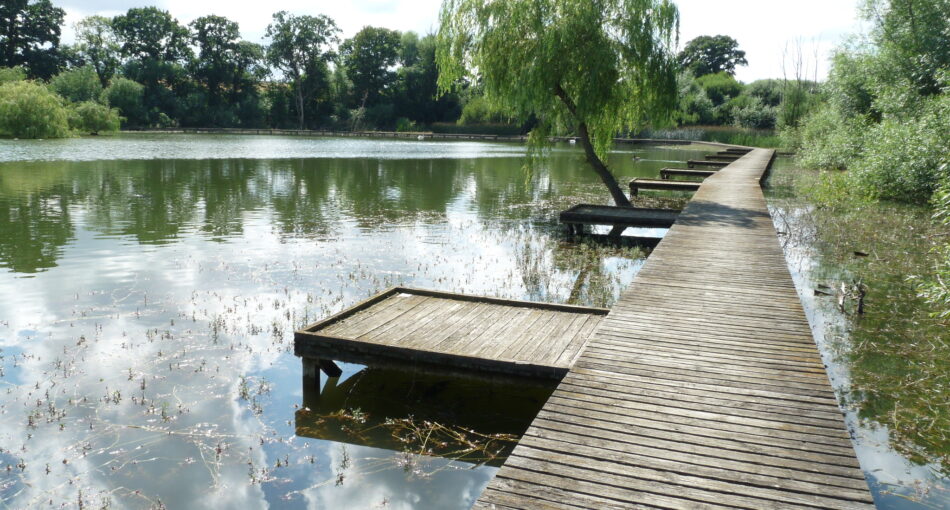Clattercote Reservoir
An attractive 21-acre landscaped reservoir with a wooden walkway most of the way around. One of the Canal and River Trust’s most popular and interesting fisheries.
Clattercote Reservoir facts and features
Built in 1787 on the site of a five acre pool belonging to Clattercote Priory when it was a lepers’ hospital, Clattercote Reservoir is 21 acres in size and holds 55 million gallons of water when full.
Unique wooden walkway
In common with nearby Drayton Reservoir, Clattercote is unusual in that it is almost completely surrounded by a modern wooden walkway which leads to 122 individual jetty-style pegs which jut out into the water. In addition there are a further 10 pegs on the concrete dam wall.
Whilst this may sound very artificial, it actually provides an unusually interesting perspective on the fishery whilst giving a solid foundation from which to fish. Indeed, the Canal and River Trust say that Clattercote is the prettiest of all their reservoir fisheries, being lined with trees and shrubs.
Where the walkway runs several metres from the bank, the attraction can be even greater as you have the impression of fishing from a private island with water and reeds behind and to either side of you and clear water in front, although anglers should note that they are not allowed to fish water behind the walkway.
Until the walkway was built most of the reservoir was unfishable. By creating the walkway not only was much of the reservoir opened up for fishing, but it also enabled most of the indigenous trees and shrubs to be retained. Additional planting of willows and reeds have made Clattercote even more attractive than it could otherwise have become.
Quiet during the week
Another nice thing is that, although the reservoir is usually fairly popular at weekends particularly when matches are being held, it is usually quiet mid-week and, with nearly 130 pegs, there is always plenty of free space for pleasure anglers and mid-week club matches.
Although the general stamp of carp does not run as large as those in its sibling rival Drayton Reservoir on the outskirts of Daventry, Clattercote is not far behind. It is different from Drayton in that it is also well stocked with tench and silver fish which, for pleasure anglers, generally means you do not know what you are going to hook into next.
Decent match catches
Matches are increasingly being won with decent catches of up to 40lbs of bream whilst the average size of individual fish is now about 2lbs, although specimens are are weighing in at around 6lbs. The match record currently stands at 160lbs.
Permits are available on the bank from the patrolling bailiff and Clattercote is unusual amongst day-ticket waters in that night fishing is also allowed. All pegs are available for matches and the fishery offers reduced rates for three-hour evening competitions on request.
The Resevoir

This attractive landscaped feeder reservoir for the Oxford Canal with its fitted wooden walkway has quickly established itself one of the Canal and River Trust’s most popular and interesting fisheries.
A range of mixed coarse fishing
A mixed coarse venue, it is heavily stocked with carp from 3lbs to 27lbs, tench to 7lbs, Crucian Carp to over 3lbs, perch to 3lbs, bream to 7lbs, pike to 27lbs and a large head of roach to 2lbs. There are also some chub which have been caught to 4lbs 8oz, although these are rarely seen.
With 100lb-plus nets of carp commonplace, bream bags in the 70lb range and roach weights of well over 20lbs regularly taken, Clattercote is a popular venue with those who know it and can master its many moods.
Most matches are won with carp and bream nets whilst 2007 has been a particularly good season for the bream with catches in excess of 70lbs being reported, even in matches.
Baits on Clattercotte – Pegs 90-120
Clattercote is said to fish best when the wind is blowing towards the dam wall whilst generally the favoured pegs tend to be 90-120 with maggot, sweetcorn and trout pellets being best for attracting and catching the fish.
The most popular techniques when fishing Clattercote are waggler fished in about eight feet of water about a rod length out for the tench and silver fish and traditional feeder, Method Feeder and increasingly the Bagging Waggler for the carp fished in open water. Traditional feeder techniques also work well for the bream in open water.
Most popular baits for non-carp anglers are bread, maggots, pellets and all the meats with sweetcorn being particularly effective, especially during the summer months. Carp anglers generally tend to stick with recognised carp baits such as boilies, paste baits, sweetcorn and meat whilst White Chocolate Boilies were proving very successful in previous seasons.
Pegs 40-50 are ideal for carp anglers
A lot of anglers who particularly target the carp tend to fish the pegs at the top end of the reservoir, particularly Pegs 40 to 50, using large baits to avoid the roach, tench and bream. When going for the carp it is recommended that anglers use a minimum line strength of 10lbs straight through to a maximum Size 8 hook.
Strong line is essential as once hooked many fish tend to bolt towards the bank, trying to find refuge under the staging and in the weeds where they can easily break free. Said to be at its best between June and November, groundbait is allowed at Clattercote but not keepnets apart from during matches when two nets are required.
Depth of the reservoir
As one would expect from the shape of the reservoir, the deepest water is at the dam end where it runs to about 25ft near the outlet. The dam wall is a very productive spot and is particularly popular with night anglers because it is flat, level and ideal for erecting bivvies. At this point floating baits such as dog biscuits are particularly effective.
About a rod length out from the sides of the reservoir the water is between five and eight feet deep, running to about 12 feet in the middle. At the top end the water is naturally shallower at about five feet and this is a favourite haunt for tench and both a very pleasant and productive part of the reservoir. Also at the top end of the reservoir are three conservation islands which provide obvious features to fish towards.
Prices
Opening Times: 24h per day all year round.
Ticket Costs |
Adults (1 Rod) | Adults (2 Rod) | OAP/Disabled/Jrs (1 Rod) | OAP/Disabled/Jrs (2 Rod) | Day |
|---|---|---|---|---|
|
|
||||
|
7.00
11.00
6.00
10.00
|
||||
| Day | 7.00 | 11.00 | 6.00 | 10.00 | Evening (5pm-9pm) |
|
|
||||
|
4.00
8.00
4.00
8.00
|
||||
| Evening (5pm-9pm) | 4.00 | 8.00 | 4.00 | 8.00 | Match Pegs |
|
|
||||
|
6.00
6.00
|
||||
| Match Pegs | 6.00 | 6.00 | Night Fishing | |
|
|
||||
|
20.00
20.00
20.00
20.00
|
||||
| Night Fishing | 20.00 | 20.00 | 20.00 | 20.00 |
How to get there
You may also be interested in
If you like this fishery in Oxfordshire then you may be interested in other fishing lakes and fisheries in Oxfordshire such as Milton Pools Fishery. Other fairly local Reservoirs that are similar include Boddington Reservoir, Drayton Reservoir and Earlswood Lakes.



















Comments